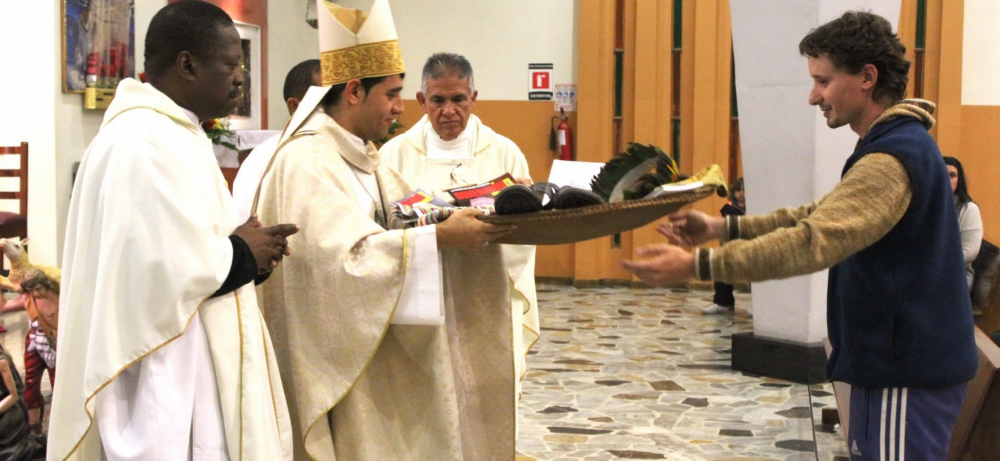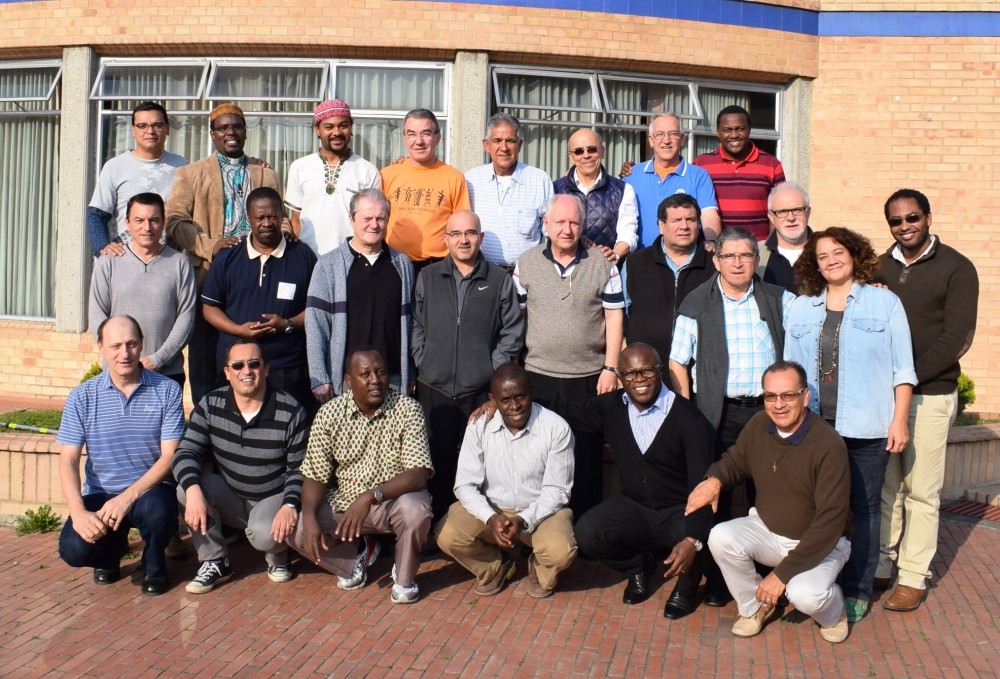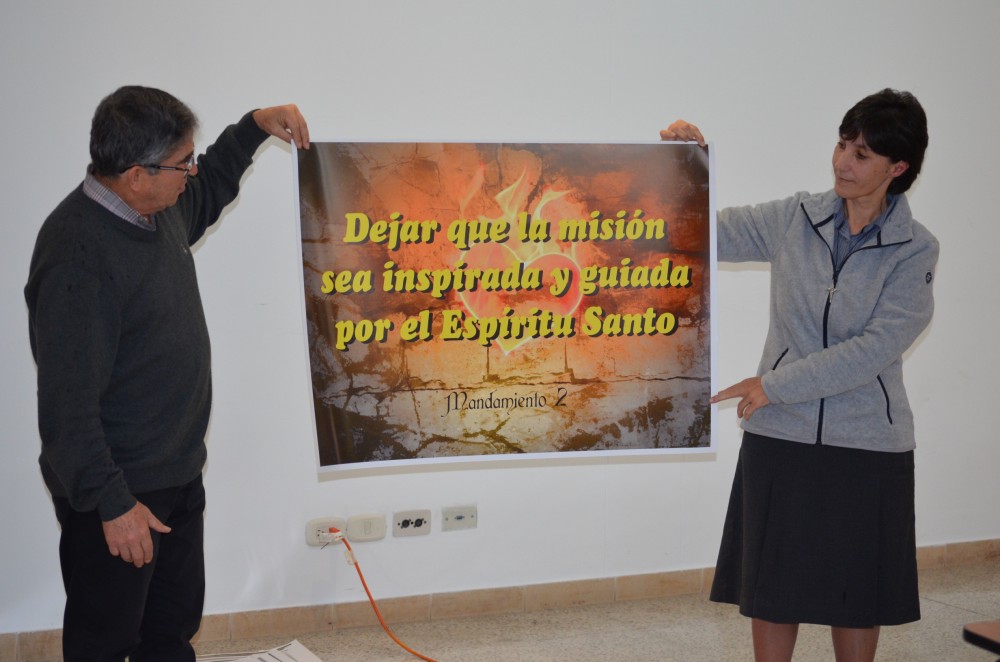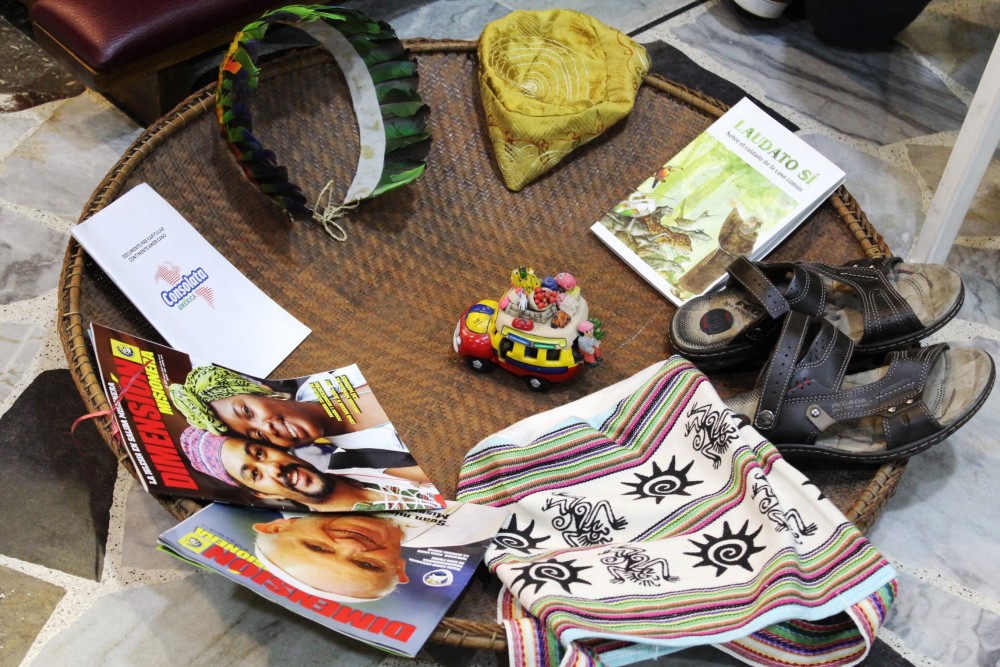Father Armando Olaya, Superior of the Consolata Missionaries in Colombia, welcomes us during Mass at the parish church of Mary Mother of the Missions in Bogota. We are the Superiors and the Delegates to the XIII General Chapter of the IMC Continent America. It is the Vigil of the Epiphany. “We came – said in his homily Msgr. Joaquin Pinzon, Bishop of Puerto Leguizamo – Solano – from different countries, guided by the star to see and adore the King of kings, and promote his meeting with everyone.”
In these very days, here in the Regional House, gather also the delegates of the Consolata Lay Missionaries for their continental meeting. In the afternoon of the first day, they give us an account of their journey, and share with us the principles of their movement’s spirituality. They stem from the same charism and have Mary as mother, model and guide. They, too, this week, work on the creation of a continental project, which they present to the Assembly at the end of their meeting.
Sister Maria Gracia, Superior of the Consolata Missionary Sisters in Colombia and Venezuela, briefs us on the path that our sisters have followed in the recent years on the continent, and particularly since their 2014 Extraordinary Chapter which outlined the steps they were to take towards the unification of various Circumscriptions. The Consolata Sisters, here in America, have adopted the option for the Indigenous peoples, and are carrying out it in every Circumscription.
The guideline of the Assembly works is the Instrumentum laboris prepared by the Continental Council, with the help of a committee ad hoc made up by Frs. Luiz Emer, Ruben Lopez and Venanzio Mwangi, and coordinated by Fr. Mauricio Guevara. It consists of a 35 page document, that like a big hamburger, at first glance puts anybody off, but eaten bite to bite, with a good pint of beer, it turns out nice and tasty! The arduous task of helping us rework the preparatory document so that it becomes the project of the American continent is entrusted to two very skilful facilitators: Mrs. Diana Sosa and Father Leonel Narvaez. They guide us, through group work and the latest techniques of methodology, to process problems, find consensus on issues, identify operational projects aimed at implementing the options adopted, outline proposals for the reorganization of the IMC structure.
The frequent change of weather, with the sun that often gives way to clouds and rain, reflects somehow the way works progress in the meeting room. To meetings where the consensus is easily reached, follow others where participants struggle to envisage solutions. An example for all: the whole assembly agrees that in America vocations to the IMC missionary life are scarce; but we have a great difficulty to find the causes of the problem and to identify the actions necessary for its overcoming.
Nine are the options the Assembly chooses for the IMC in America:
– the Amazon basin,
– the urban peripheries,
– the Afro-descendants,
– the Indigenous peoples,
– the migrants and refugees,
– the existential peripheries,
– the youth,
– justice, peace and integrity of creation,
– inter-religious dialogue.
Of course not all Circumscriptions will be directly committed in all these options, but all are called to take them on to ensure that they are carried out where a Circumscription or another, in communion with the Continent, chooses to commit itself in one or more.
A particular emphasis is given to young people both for their fragility and their resources. Their world should draw our attention as shepherds, sowers of the word and fishermen. The services to the mission we carry out in every Circumscription – Missionary Animation, Vocation Promotion, formal and informal Education, Communication and Formation – cannot but have young people as the focus of our care and the priority goal of our action.
A commission made up of Fr. Jaime C. Patias and Fr. Jean-Marie Bilwala, has prepared a Power Point presentation on the theme of communication. It brought our attention on the fact that the social media (printed and electronic media) are only the tools of a larger reality: the world of communication. A world where we are all actors; we all put across a message: starting from the way we preach, and even through the very way in which we dress! However the world of communication is also a world occupied by many who are difficult to reach through other means except precisely through the social media: a true Areopagus therefore – a world to be evangelized!
Each day begins with a moment of “biblical illumination” animated Professor César Baratto of the Xaverian University. He guides us to listen to God’s Word from the perspective of the Latin American people, who place life, and life to the full, at the center of their religious horizon. The source of inspiration is the Antioch Church and especially the apostles Paul and Barnabas. We follow their footsteps among the difficulties they encountered, the conflicts and achievements, trying to do, as they did, a reading within the light of faith of our lives and our history.
The day is crowned with the Eucharist. At the altar take turn Fr. Dietrich Pendawazima, Vice Superior General, Fr. Claudio Brualdi, in memory of his 50th anniversary of priesthood, Fr. Ugo Pozzoli, Fr. Daniel Wolde Sugamo, on his birthday, Fr. Jaime Patias and, at the closing Mass, Fr. Stefano Camerlengo, Superior General.
These two daily moments of prayer help us to understand that there can be no re-organization of our Institute without revitalization. Source of effective change is the conversion of the missionary to the plan of God for the world (Acts 11:18), the awareness that we are justified by faith in Him for a life driven by hope and overflowing of the love that the Spirit has infused into our hearts (Rom. 5,1-5).
Together with the Eucharist, certainly the meal times are among the most beautiful ones. Not only because we sit around the table enjoying being together, but also because there we have the opportunity to savor all the delights of the Colombian cuisine – like, for instance, the arepas and the empanadas – and also to try fruits never seen before, although not without surprises! Such as lemons which to the sight – but not to the palate! – appear to be nectarines!!!
The welcome we received was outstanding. The heart of all of us are filled with thanks to Fr. Oscar Gallego, Superior of the community, to Fr. Van Hager, his Deputy, to Fr. Julius Calderas, in charge of the logistic, as well as to all the reception, kitchen and laundry staff: they all did their best to make us feel at home!
The success of a community surely first depends on its members, but also the management and its financial administration. Likewise, the Continent project could not miss a section on the financial administration (economy) and on the IMC structure (models of government).
The methodology adopted for the discussion on the financial administration foresees a novelty. We split into two groups with the task to highlight six issues, analyze them and turn them into goals. How to do that? The secret, we are told, is to identify the root causes of the issue and change them into actions to be undertaken to overcome the issue. Among the problems emerges the fact that we take lightly the administration, reducing it to simple accounting; but above all that we swim in the sea of new-liberal ideology, where all spins around the success of the individual. The focus is on the art of selfishly making do without scruples. Who matters is the one who has money. Often the development projects are not community centered, but the achievement of an individual missionary; with the result that they wreck when the missionary concerned is not there any more. Frequently also in our missions we inherit situations where people have been accustomed to dependence; a condition which it is not easy for them to overcome.
More eventful is the discussion about the choice of new models of IMC government. As in the caucuses which characterize the American primaries, where voters gather around the candidate of their choice, so the vast majority of the Assembly physically gathers under the sign depicting model “1”. Model “1” provides for a General Council composed of seven members: the Superior General, the Vice Superior General and five General Councilors (the first, called the General Councilor outright, who, we would say, is “without portfolio”; the other four – called General Continental Councilors – represent, each one of the four IMC continents). A directory has to be set up in order to determine which decisions can be taken, present all seven members of the General Council; which ones, present the top three (Superior General, Vice Superior General and General Councilor “without portfolio”); and which ones, finally, present the Superior General, the Vice Superior General and the General Continental Councilor of a particular continent. The majority of the Assembly presents to the minority the benefits of the model “1”; and the minority, on the other hand, its disadvantages.
The final document – drawn up patiently by Father Jenaro Ardila and Prof. Ricardo, the two very valid secretaries of the Assembly – we had all hoped it would have been shorter than the preparatory one. Instead it turns out it is longer. We put a lot of meat on the fire and we hope not to cause indigestion to the members of the Chapter and to the other missionaries who will read it!
I cannot end without mentioning two other things.
The first is the hospitality of the members of the Regional House.
Already on the first day of my stay, P. Van Hager, my fellow community member in Somerset, kindly offers to take me on a tour of the center of Bogota. He usually goes around by bicycle: the faster means of transport in town. But today – fortunately – we go by bus and then get back with a private taxi – such as those that in Kenya are called “Matato” – where, however, once the seats are filled, nobody else is allowed in. I found very interesting the building that hosts the Archeology Museum, the colonial-style houses with gardens, the Cathedral and the Presidential Palace, with the guards in high uniform. Along the central Carrera 7 we pause, along with hundreds of passers-by, to observe the many outdoor shows staged by artists of all kinds.
Sunday, January 8, Fr. Armando Olaya invites Fr. Ruben López and myself to celebrate the Eucharist with him at “Aguas Claras”, a Bogota suburb. We celebrate Mass in the building where the Local Area Council gathers. It is the Day of the Epiphany. At the homily, Fr. Ruben cannot but say that the Son of God was not born in a palace, but in a poor house like the one where we are saying Mass or like those in which the people here present live. After the Eucharist, we are invited for breakfast by a family in their house. A cup of chocolate and a tamal is readily served to each of us. On the way back, we visit a sick person. He is bed ridden, yet – miracle! -, when he sees Fr. Armando, he gets out of bed, takes us into the backdoor garden and invites us to help ourselves with celery and other vegetables for lunch! We are all speechless: poor and sick people; yet how friendly and generous …and ready to get out to the open!
Fr. Leonel has the kindness to invite Fr. Daniel Wolde, on his birthday, and myself, out for a pizza at “La Trattoria”: a restaurant not far from the Regional House. The tables of the mall, where the restaurant is located, are filled with happy people having a drink or a meal. It is evident that the people who are here enjoy a good standard of living. “It is – says to us Fr. Leonel – the result of a fairly satisfying economic growth that in 2016, at national level, reached 2.8%”.
The second thing I like is to underscore is the constant presence and the participation of the General Council to the Assembly. We all have the opportunity to meet personally with the Father General, the Vice or one of the Councilors. Besides, every night the General Council encounters the Circumscriptions, one by one. We live and grow in brotherhood. A great thank goes to each of them and in particular to Fr. Salvador Medina for the organization of this Assembly.
I round up by recalling the three words that the Father General has entrusted to us in his final message: depth, joy and love for the mission. The temptation to superficiality, to let ourselves be overcome by discouragement and sadness, and to sit down instead of going out to the open is strong. The antidote is, on the one hand, to return to the founding charism of the IMC, and, on the other, to open ourselves with trust to the action of the Spirit, who leads us in the mission and is present not only among us, but in all the earth.
Paolo Fedrigoni, IMC
Bogota, January 15, 2017.




